Problem Set 8: Real Numbers
Practice Makes Perfect Rational Numbers In the following exercises, write as the ratio of two integers.- ⓐ [latex]5[/latex]
- ⓑ [latex]3.19[/latex]
- ⓐ [latex]\frac{5}{1}[/latex]
- ⓑ [latex]\frac{319}{100}[/latex]
- ⓐ [latex]8[/latex]
- ⓑ [latex]-1.61[/latex]
- ⓐ [latex]-12[/latex]
- ⓑ [latex]9.279[/latex]
- ⓐ [latex]\frac{-12}{1}[/latex]
- ⓑ [latex]\frac{9279}{1000}[/latex]
- ⓐ [latex]-16[/latex]
- ⓑ [latex]4.399[/latex]
- ⓐ [latex]\sqrt{25}[/latex]
- ⓑ [latex]\sqrt{30}[/latex]
- ⓐ rational
- ⓑ irrational
- ⓐ [latex]\sqrt{44}[/latex]
- ⓑ [latex]\sqrt{49}[/latex]
- ⓐ [latex]\sqrt{164}[/latex]
- ⓑ [latex]\sqrt{169}[/latex]
- ⓐ irrational
- ⓑ rational
- ⓐ [latex]\sqrt{225}[/latex]
- ⓑ [latex]\sqrt{216}[/latex]
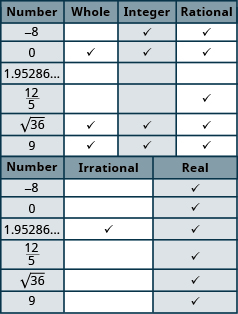 [latex-display]-9[/latex] , [latex]-3\frac{4}{9}[/latex] , [latex]-\sqrt{9}[/latex] , [latex]0.4\stackrel{\text{-}}{09}[/latex] , [latex]\frac{11}{6}[/latex] , [latex]7[/latex-display]
[latex-display]-\sqrt{100}[/latex] , [latex]-7[/latex] , [latex]-\frac{8}{3}[/latex] , [latex]-1[/latex] , [latex]0.77[/latex] , [latex]3\frac{1}{4}[/latex-display]
[latex-display]-9[/latex] , [latex]-3\frac{4}{9}[/latex] , [latex]-\sqrt{9}[/latex] , [latex]0.4\stackrel{\text{-}}{09}[/latex] , [latex]\frac{11}{6}[/latex] , [latex]7[/latex-display]
[latex-display]-\sqrt{100}[/latex] , [latex]-7[/latex] , [latex]-\frac{8}{3}[/latex] , [latex]-1[/latex] , [latex]0.77[/latex] , [latex]3\frac{1}{4}[/latex-display]
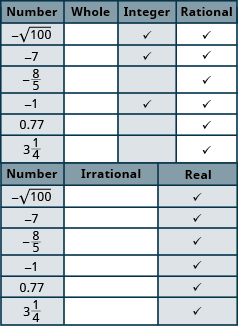
Everyday Math
Field trip All the [latex]5\text{th}[/latex] graders at Lincoln Elementary School will go on a field trip to the science museum. Counting all the children, teachers, and chaperones, there will be [latex]147[/latex] people. Each bus holds [latex]44[/latex] people. ⓐ How many buses will be needed? ⓑ Why must the answer be a whole number? ⓒ Why shouldn't you round the answer the usual way? Child care Serena wants to open a licensed child care center. Her state requires that there be no more than [latex]12[/latex] children for each teacher. She would like her child care center to serve [latex]40[/latex] children. ⓐ How many teachers will be needed? ⓑ Why must the answer be a whole number? ⓒ Why shouldn't you round the answer the usual way? ⓐ 4 ⓑ Teachers cannot be divided ⓒ It would result in a lower number.Writing Exercises
In your own words, explain the difference between a rational number and an irrational number. Explain how the sets of numbers (counting, whole, integer, rational, irrationals, reals) are related to each other. Answers will vary.Self Check
ⓐ After completing the exercises, use this checklist to evaluate your mastery of the objectives of this section. ⓑ If most of your checks were:
…confidently. Congratulations! You have achieved the objectives in this section. Reflect on the study skills you used so that you can continue to use them. What did you do to become confident of your ability to do these things? Be specific.
…with some help. This must be addressed quickly because topics you do not master become potholes in your road to success. In math, every topic builds upon previous work. It is important to make sure you have a strong foundation before you move on. Who can you ask for help? Your fellow classmates and instructor are good resources. Is there a place on campus where math tutors are available? Can your study skills be improved?
…no—I don’t get it! This is a warning sign and you must not ignore it. You should get help right away or you will quickly be overwhelmed. See your instructor as soon as you can to discuss your situation. Together you can come up with a plan to get you the help you need.
commutative and associative properties
ⓑ If most of your checks were:
…confidently. Congratulations! You have achieved the objectives in this section. Reflect on the study skills you used so that you can continue to use them. What did you do to become confident of your ability to do these things? Be specific.
…with some help. This must be addressed quickly because topics you do not master become potholes in your road to success. In math, every topic builds upon previous work. It is important to make sure you have a strong foundation before you move on. Who can you ask for help? Your fellow classmates and instructor are good resources. Is there a place on campus where math tutors are available? Can your study skills be improved?
…no—I don’t get it! This is a warning sign and you must not ignore it. You should get help right away or you will quickly be overwhelmed. See your instructor as soon as you can to discuss your situation. Together you can come up with a plan to get you the help you need.
commutative and associative properties
Practice Makes Perfect
Use the Commutative and Associative Properties In the following exercises, use the commutative properties to rewrite the given expression. [latex-display]8+9=___[/latex-display] [latex-display]7+6=___[/latex-display] 7 + 6 = 6 + 7 [latex-display]8\left(-12\right)=___[/latex-display] [latex-display]7\left(-13\right)=___[/latex-display] 7(−13) = (−13)7 [latex-display]\left(-19\right)\left(-14\right)=___[/latex-display] [latex-display]\left(-12\right)\left(-18\right)=___[/latex-display] (−12)(−18) = (−18)(−12) [latex-display]-11+8=___[/latex-display] [latex-display]-15+7=___[/latex-display] −15 + 7 = 7 + (−15) [latex-display]x+4=___[/latex-display] [latex-display]y+1=___[/latex-display] y + 1 = 1 + y [latex-display]-2a=___[/latex-display] [latex-display]-3m=___[/latex-display] −3m = m(−3) In the following exercises, use the associative properties to rewrite the given expression. [latex-display]\left(11+9\right)+14=___[/latex-display] [latex-display]\left(21+14\right)+9=___[/latex-display] (21 + 14) + 9 = 21 + (14 + 9) [latex-display]\left(12\cdot 5\right)\cdot 7=___[/latex-display] [latex-display]\left(14\cdot 6\right)\cdot 9=___[/latex-display] (14 · 6) · 9 = 14(6 · 9) [latex-display]\left(-7+9\right)+8=___[/latex-display] [latex-display]\left(-2+6\right)+7=___[/latex-display] (−2 + 6) + 7 = −2 + (6 + 7) [latex-display]\left(16\cdot \frac{4}{5}\right)\cdot 15=___[/latex-display] [latex-display]\left(13\cdot \frac{2}{3}\right)\cdot 18=___[/latex-display] [latex-display]\left(13\cdot \frac{2}{3}\right)\cdot 18=13\left(\frac{2}{3}\cdot 18\right)[/latex-display] [latex-display]3\left(4x\right)=___[/latex-display] [latex-display]4\left(7x\right)=___[/latex-display] 4(7x) = (4 · 7)x [latex-display]\left(12+x\right)+28=___[/latex-display] [latex-display]\left(17+y\right)+33=___[/latex-display] (17 + y) + 33 = 17 + (y + 33) Evaluate Expressions using the Commutative and Associative Properties In the following exercises, evaluate each expression for the given value. If [latex]y=\frac{5}{8}[/latex], evaluate: ⓐ [latex]y+0.49+\left(-y\right)[/latex] ⓑ [latex]y+\left(-y\right)+0.49[/latex] If [latex]z=\frac{7}{8}[/latex], evaluate: ⓐ [latex]z+0.97+\left(-z\right)[/latex] ⓑ [latex]z+\left(-z\right)+0.97[/latex]- ⓐ 0.97
- ⓑ 0.97
Everyday Math
Stamps Allie and Loren need to buy stamps. Allie needs four [latex]\text{$0.49}[/latex] stamps and nine [latex]\text{$0.02}[/latex] stamps. Loren needs eight [latex]\text{$0.49}[/latex] stamps and three [latex]\text{$0.02}[/latex] stamps. ⓐ How much will Allie’s stamps cost? ⓑ How much will Loren’s stamps cost? ⓒ What is the total cost of the girls’ stamps? ⓓ How many [latex]\text{$0.49}[/latex] stamps do the girls need altogether? How much will they cost? ⓔ How many [latex]\text{$0.02}[/latex] stamps do the girls need altogether? How much will they cost? Counting Cash Grant is totaling up the cash from a fundraising dinner. In one envelope, he has twenty-three [latex]\text{$5}[/latex] bills, eighteen [latex]\text{$10}[/latex] bills, and thirty-four [latex]\text{$20}[/latex] bills. In another envelope, he has fourteen [latex]\text{$5}[/latex] bills, nine [latex]\text{$10}[/latex] bills, and twenty-seven [latex]\text{$20}[/latex] bills. ⓐ How much money is in the first envelope? ⓑ How much money is in the second envelope? ⓒ What is the total value of all the cash? ⓓ What is the value of all the [latex]\text{$5}[/latex] bills? ⓔ What is the value of all [latex]\text{$10}[/latex] bills? ⓕ What is the value of all [latex]\text{$20}[/latex] bills?- ⓐ $975
- ⓑ $700
- ⓒ $1675
- ⓓ $185
- ⓔ $270
- ⓕ $1220
Writing Exercises
In your own words, state the Commutative Property of Addition and explain why it is useful. In your own words, state the Associative Property of Multiplication and explain why it is useful. Answers will vary.Self Check
ⓐ After completing the exercises, use this checklist to evaluate your mastery of the objectives of this section. ⓑ After reviewing this checklist, what will you do to become confident for all objectives?
Practice Makes Perfect
Simplify Expressions Using the Distributive Property
In the following exercises, simplify using the distributive property.
[latex-display]4\left(x+8\right)[/latex-display]
[latex-display]3\left(a+9\right)[/latex-display]
3a + 27
[latex-display]8\left(4y+9\right)[/latex-display]
[latex-display]9\left(3w+7\right)[/latex-display]
27w + 63
[latex-display]6\left(c - 13\right)[/latex-display]
[latex-display]7\left(y - 13\right)[/latex-display]
7y − 91
[latex-display]7\left(3p - 8\right)[/latex-display]
[latex-display]5\left(7u - 4\right)[/latex-display]
35u − 20
[latex-display]\frac{1}{2}\left(n+8\right)[/latex-display]
[latex-display]\frac{1}{3}\left(u+9\right)[/latex-display]
[latex-display]\frac{1}{3}u+3[/latex-display]
[latex-display]\frac{1}{4}\left(3q+12\right)[/latex-display]
[latex-display]\frac{1}{5}\left(4m+20\right)[/latex-display]
[latex-display]\frac{4}{5}m+4[/latex-display]
[latex-display]9\left(\frac{5}{9}y-\frac{1}{3}\right)[/latex-display]
[latex-display]10\left(\frac{3}{10}x-\frac{2}{5}\right)[/latex-display]
3x − 4
[latex-display]12\left(\frac{1}{4}+\frac{2}{3}r\right)[/latex-display]
[latex-display]12\left(\frac{1}{6}+\frac{3}{4}s\right)[/latex-display]
2 + 9s
[latex-display]r\left(s - 18\right)[/latex-display]
[latex-display]u\left(v - 10\right)[/latex-display]
uv − 10u
[latex-display]\left(y+4\right)p[/latex-display]
[latex-display]\left(a+7\right)x[/latex-display]
ax + 7x
[latex-display]-2\left(y+13\right)[/latex-display]
[latex-display]-3\left(a+11\right)[/latex-display]
−3a − 33
[latex-display]-7\left(4p+1\right)[/latex-display]
[latex-display]-9\left(9a+4\right)[/latex-display]
−81a − 36
[latex-display]-3\left(x - 6\right)[/latex-display]
[latex-display]-4\left(q - 7\right)[/latex-display]
−4q + 28
[latex-display]-9\left(3a - 7\right)[/latex-display]
[latex-display]-6\left(7x - 8\right)[/latex-display]
−42x + 48
[latex-display]-\left(r+7\right)[/latex-display]
[latex-display]-\left(q+11\right)[/latex-display]
−q − 11
[latex-display]-\left(3x - 7\right)[/latex-display]
[latex-display]-\left(5p - 4\right)[/latex-display]
−5p + 4
[latex-display]5+9\left(n - 6\right)[/latex-display]
[latex-display]12+8\left(u - 1\right)[/latex-display]
8u + 4
[latex-display]16 - 3\left(y+8\right)[/latex-display]
[latex-display]18 - 4\left(x+2\right)[/latex-display]
−4x + 10
[latex-display]4 - 11\left(3c - 2\right)[/latex-display]
[latex-display]9 - 6\left(7n - 5\right)[/latex-display]
−42n + 39
[latex-display]22-\left(a+3\right)[/latex-display]
[latex-display]8-\left(r - 7\right)[/latex-display]
−r + 15
[latex-display]-12-\left(u+10\right)[/latex-display]
[latex-display]-4-\left(c - 10\right)[/latex-display]
−c + 6
[latex-display]\left(5m - 3\right)-\left(m+7\right)[/latex-display]
[latex-display]\left(4y - 1\right)-\left(y - 2\right)[/latex-display]
3y + 1
[latex-display]5\left(2n+9\right)+12\left(n - 3\right)[/latex-display]
[latex-display]9\left(5u+8\right)+2\left(u - 6\right)[/latex-display]
47u + 60
[latex-display]9\left(8x - 3\right)-\left(-2\right)[/latex-display]
[latex-display]4\left(6x - 1\right)-\left(-8\right)[/latex-display]
24x + 4
[latex-display]14\left(c - 1\right)-8\left(c - 6\right)[/latex-display]
[latex-display]11\left(n - 7\right)-5\left(n - 1\right)[/latex-display]
6n − 72
[latex-display]6\left(7y+8\right)-\left(30y - 15\right)[/latex-display]
[latex-display]7\left(3n+9\right)-\left(4n - 13\right)[/latex-display]
17n + 76
Evaluate Expressions Using the Distributive Property
In the following exercises, evaluate both expressions for the given value.
If [latex]v=-2[/latex], evaluate
ⓐ [latex]6\left(4v+7\right)[/latex]
ⓑ [latex]6\cdot 4v+6\cdot 7[/latex]
If [latex]u=-1[/latex], evaluate
ⓐ [latex]8\left(5u+12\right)[/latex]
ⓑ [latex]8\cdot 5u+8\cdot 12[/latex]
ⓐ 56
ⓑ 56
If [latex]n=\frac{2}{3}[/latex], evaluate
ⓐ [latex]3\left(n+\frac{5}{6}\right)[/latex]
ⓑ [latex]3\cdot n+3\cdot \frac{5}{6}[/latex]
If [latex]y=\frac{3}{4}[/latex], evaluate
ⓐ [latex]4\left(y+\frac{3}{8}\right)[/latex]
ⓑ [latex]4\cdot y+4\cdot \frac{3}{8}[/latex]
ⓐ [latex]\frac{9}{2}[/latex]
ⓑ [latex]\frac{9}{2}[/latex]
If [latex]y=\frac{7}{12}[/latex], evaluate
ⓐ [latex]-3\left(4y+15\right)[/latex]
ⓑ [latex]3\cdot 4y+\left(-3\right)\cdot 15[/latex]
If [latex]p=\frac{23}{30}[/latex], evaluate
ⓐ [latex]-6\left(5p+11\right)[/latex]
ⓑ [latex]-6\cdot 5p+\left(-6\right)\cdot 11[/latex]
ⓐ −89
ⓑ −89
If [latex]m=0.4[/latex], evaluate
ⓐ [latex]-10\left(3m - 0.9\right)[/latex]
ⓑ [latex]-10\cdot 3m-\left(-10\right)\left(0.9\right)[/latex]
If [latex]n=0.75[/latex], evaluate
ⓐ [latex]-100\left(5n+1.5\right)[/latex]
ⓑ [latex]-100\cdot 5n+\left(-100\right)\left(1.5\right)[/latex]
ⓐ −525
ⓑ −525
If [latex]y=-25[/latex], evaluate
ⓐ [latex]-\left(y - 25\right)[/latex]
ⓑ [latex]-y+25[/latex]
If [latex]w=-80[/latex], evaluate
ⓐ [latex]-\left(w - 80\right)[/latex]
ⓑ [latex]-w+80[/latex]
ⓐ 160
ⓑ 160
If [latex]p=0.19[/latex], evaluate
ⓐ [latex]-\left(p+0.72\right)[/latex]
ⓑ [latex]-p - 0.72[/latex]
If [latex]q=0.55[/latex], evaluate
ⓐ [latex]-\left(q+0.48\right)[/latex]
ⓑ [latex]-q - 0.48[/latex]
ⓐ −1.03
ⓑ −1.03
ⓑ After reviewing this checklist, what will you do to become confident for all objectives?
Practice Makes Perfect
Simplify Expressions Using the Distributive Property
In the following exercises, simplify using the distributive property.
[latex-display]4\left(x+8\right)[/latex-display]
[latex-display]3\left(a+9\right)[/latex-display]
3a + 27
[latex-display]8\left(4y+9\right)[/latex-display]
[latex-display]9\left(3w+7\right)[/latex-display]
27w + 63
[latex-display]6\left(c - 13\right)[/latex-display]
[latex-display]7\left(y - 13\right)[/latex-display]
7y − 91
[latex-display]7\left(3p - 8\right)[/latex-display]
[latex-display]5\left(7u - 4\right)[/latex-display]
35u − 20
[latex-display]\frac{1}{2}\left(n+8\right)[/latex-display]
[latex-display]\frac{1}{3}\left(u+9\right)[/latex-display]
[latex-display]\frac{1}{3}u+3[/latex-display]
[latex-display]\frac{1}{4}\left(3q+12\right)[/latex-display]
[latex-display]\frac{1}{5}\left(4m+20\right)[/latex-display]
[latex-display]\frac{4}{5}m+4[/latex-display]
[latex-display]9\left(\frac{5}{9}y-\frac{1}{3}\right)[/latex-display]
[latex-display]10\left(\frac{3}{10}x-\frac{2}{5}\right)[/latex-display]
3x − 4
[latex-display]12\left(\frac{1}{4}+\frac{2}{3}r\right)[/latex-display]
[latex-display]12\left(\frac{1}{6}+\frac{3}{4}s\right)[/latex-display]
2 + 9s
[latex-display]r\left(s - 18\right)[/latex-display]
[latex-display]u\left(v - 10\right)[/latex-display]
uv − 10u
[latex-display]\left(y+4\right)p[/latex-display]
[latex-display]\left(a+7\right)x[/latex-display]
ax + 7x
[latex-display]-2\left(y+13\right)[/latex-display]
[latex-display]-3\left(a+11\right)[/latex-display]
−3a − 33
[latex-display]-7\left(4p+1\right)[/latex-display]
[latex-display]-9\left(9a+4\right)[/latex-display]
−81a − 36
[latex-display]-3\left(x - 6\right)[/latex-display]
[latex-display]-4\left(q - 7\right)[/latex-display]
−4q + 28
[latex-display]-9\left(3a - 7\right)[/latex-display]
[latex-display]-6\left(7x - 8\right)[/latex-display]
−42x + 48
[latex-display]-\left(r+7\right)[/latex-display]
[latex-display]-\left(q+11\right)[/latex-display]
−q − 11
[latex-display]-\left(3x - 7\right)[/latex-display]
[latex-display]-\left(5p - 4\right)[/latex-display]
−5p + 4
[latex-display]5+9\left(n - 6\right)[/latex-display]
[latex-display]12+8\left(u - 1\right)[/latex-display]
8u + 4
[latex-display]16 - 3\left(y+8\right)[/latex-display]
[latex-display]18 - 4\left(x+2\right)[/latex-display]
−4x + 10
[latex-display]4 - 11\left(3c - 2\right)[/latex-display]
[latex-display]9 - 6\left(7n - 5\right)[/latex-display]
−42n + 39
[latex-display]22-\left(a+3\right)[/latex-display]
[latex-display]8-\left(r - 7\right)[/latex-display]
−r + 15
[latex-display]-12-\left(u+10\right)[/latex-display]
[latex-display]-4-\left(c - 10\right)[/latex-display]
−c + 6
[latex-display]\left(5m - 3\right)-\left(m+7\right)[/latex-display]
[latex-display]\left(4y - 1\right)-\left(y - 2\right)[/latex-display]
3y + 1
[latex-display]5\left(2n+9\right)+12\left(n - 3\right)[/latex-display]
[latex-display]9\left(5u+8\right)+2\left(u - 6\right)[/latex-display]
47u + 60
[latex-display]9\left(8x - 3\right)-\left(-2\right)[/latex-display]
[latex-display]4\left(6x - 1\right)-\left(-8\right)[/latex-display]
24x + 4
[latex-display]14\left(c - 1\right)-8\left(c - 6\right)[/latex-display]
[latex-display]11\left(n - 7\right)-5\left(n - 1\right)[/latex-display]
6n − 72
[latex-display]6\left(7y+8\right)-\left(30y - 15\right)[/latex-display]
[latex-display]7\left(3n+9\right)-\left(4n - 13\right)[/latex-display]
17n + 76
Evaluate Expressions Using the Distributive Property
In the following exercises, evaluate both expressions for the given value.
If [latex]v=-2[/latex], evaluate
ⓐ [latex]6\left(4v+7\right)[/latex]
ⓑ [latex]6\cdot 4v+6\cdot 7[/latex]
If [latex]u=-1[/latex], evaluate
ⓐ [latex]8\left(5u+12\right)[/latex]
ⓑ [latex]8\cdot 5u+8\cdot 12[/latex]
ⓐ 56
ⓑ 56
If [latex]n=\frac{2}{3}[/latex], evaluate
ⓐ [latex]3\left(n+\frac{5}{6}\right)[/latex]
ⓑ [latex]3\cdot n+3\cdot \frac{5}{6}[/latex]
If [latex]y=\frac{3}{4}[/latex], evaluate
ⓐ [latex]4\left(y+\frac{3}{8}\right)[/latex]
ⓑ [latex]4\cdot y+4\cdot \frac{3}{8}[/latex]
ⓐ [latex]\frac{9}{2}[/latex]
ⓑ [latex]\frac{9}{2}[/latex]
If [latex]y=\frac{7}{12}[/latex], evaluate
ⓐ [latex]-3\left(4y+15\right)[/latex]
ⓑ [latex]3\cdot 4y+\left(-3\right)\cdot 15[/latex]
If [latex]p=\frac{23}{30}[/latex], evaluate
ⓐ [latex]-6\left(5p+11\right)[/latex]
ⓑ [latex]-6\cdot 5p+\left(-6\right)\cdot 11[/latex]
ⓐ −89
ⓑ −89
If [latex]m=0.4[/latex], evaluate
ⓐ [latex]-10\left(3m - 0.9\right)[/latex]
ⓑ [latex]-10\cdot 3m-\left(-10\right)\left(0.9\right)[/latex]
If [latex]n=0.75[/latex], evaluate
ⓐ [latex]-100\left(5n+1.5\right)[/latex]
ⓑ [latex]-100\cdot 5n+\left(-100\right)\left(1.5\right)[/latex]
ⓐ −525
ⓑ −525
If [latex]y=-25[/latex], evaluate
ⓐ [latex]-\left(y - 25\right)[/latex]
ⓑ [latex]-y+25[/latex]
If [latex]w=-80[/latex], evaluate
ⓐ [latex]-\left(w - 80\right)[/latex]
ⓑ [latex]-w+80[/latex]
ⓐ 160
ⓑ 160
If [latex]p=0.19[/latex], evaluate
ⓐ [latex]-\left(p+0.72\right)[/latex]
ⓑ [latex]-p - 0.72[/latex]
If [latex]q=0.55[/latex], evaluate
ⓐ [latex]-\left(q+0.48\right)[/latex]
ⓑ [latex]-q - 0.48[/latex]
ⓐ −1.03
ⓑ −1.03
Everyday Math
Buying by the case Joe can buy his favorite ice tea at a convenience store for [latex]\text{$1.99}[/latex] per bottle. At the grocery store, he can buy a case of [latex]12[/latex] bottles for [latex]\text{$23.88}[/latex]. ⓐ Use the distributive property to find the cost of [latex]12[/latex] bottles bought individually at the convenience store. (Hint: notice that [latex]\text{$1.99}[/latex] is [latex]\text{$2}-\text{$0.01}[/latex]. ) ⓑ Is it a bargain to buy the iced tea at the grocery store by the case? Multi-pack purchase Adele’s shampoo sells for [latex]\text{$3.97}[/latex] per bottle at the drug store. At the warehouse store, the same shampoo is sold as a [latex]\text{3-pack}[/latex] for [latex]\text{$10.49}[/latex]. ⓐ Show how you can use the distributive property to find the cost of [latex]3[/latex] bottles bought individually at the drug store. ⓑ How much would Adele save by buying the [latex]\text{3-pack}[/latex] at the warehouse store? ⓐ 3(4 − 0.03) = 11.91 ⓑ $1.42Writing Exercises
Simplify [latex]8\left(x-\frac{1}{4}\right)[/latex] using the distributive property and explain each step. Explain how you can multiply [latex]4\left(\text{$5.97}\right)[/latex] without paper or a calculator by thinking of [latex]\text{$5.97}[/latex] as [latex]6 - 0.03[/latex] and then using the distributive property.Self Check
ⓐ After completing the exercises, use this checklist to evaluate your mastery of the objectives of this section. ⓑ What does this checklist tell you about your mastery of this section? What steps will you take to improve?
ⓑ What does this checklist tell you about your mastery of this section? What steps will you take to improve?
Practice Makes Perfect
Recognize the Identity Properties of Addition and Multiplication In the following exercises, identify whether each example is using the identity property of addition or multiplication. [latex-display]101+0=101[/latex-display] [latex-display]\frac{3}{5}\left(1\right)=\frac{3}{5}[/latex-display] identity property of multiplication [latex-display]-9\cdot 1=-9[/latex-display] [latex-display]0+64=64[/latex-display] identity property of addition Use the Inverse Properties of Addition and Multiplication In the following exercises, find the multiplicative inverse. [latex-display]8[/latex-display] [latex-display]14[/latex-display] [latex-display]\frac{1}{14}[/latex-display] [latex-display]-17[/latex-display] [latex-display]-19[/latex-display] [latex-display]-\frac{1}{19}[/latex-display] [latex-display]\frac{7}{12}[/latex-display] [latex-display]\frac{8}{13}[/latex-display] [latex-display]\frac{13}{8}[/latex-display] [latex-display]-\frac{3}{10}[/latex-display] [latex-display]-\frac{5}{12}[/latex-display] [latex-display]-\frac{12}{5}[/latex-display] [latex-display]0.8[/latex-display] [latex-display]0.4[/latex-display] [latex-display]\frac{5}{2}[/latex-display] [latex-display]-0.2[/latex-display] [latex-display]-0.5[/latex-display] −2 Use the Properties of Zero In the following exercises, simplify using the properties of zero. [latex-display]48\cdot 0[/latex-display] [latex-display]\frac{0}{6}[/latex-display] 0 [latex-display]\frac{3}{0}[/latex-display] [latex-display]22\cdot 0[/latex-display] 0 [latex-display]0\div \frac{11}{12}[/latex-display] [latex-display]\frac{6}{0}[/latex-display] undefined [latex-display]\frac{0}{3}[/latex-display] [latex-display]0\div \frac{7}{15}[/latex-display] 0 [latex-display]0\cdot \frac{8}{15}[/latex-display] [latex-display]\left(-3.14\right)\left(0\right)[/latex-display] 0 [latex-display]5.72\div 0[/latex-display] [latex-display]\frac{\frac{1}{10}}{0}[/latex-display] undefined Simplify Expressions using the Properties of Identities, Inverses, and Zero In the following exercises, simplify using the properties of identities, inverses, and zero. [latex-display]19a+44 - 19a[/latex-display] [latex-display]27c+16 - 27c[/latex-display] 16 [latex-display]38+11r - 38[/latex-display] [latex-display]92+31s - 92[/latex-display] 31s [latex-display]10\left(0.1d\right)[/latex-display] [latex-display]100\left(0.01p\right)[/latex-display] p [latex-display]5\left(0.6q\right)[/latex-display] [latex-display]40\left(0.05n\right)[/latex-display] 2n [latex-display]\frac{0}{r+20}[/latex] , where [latex]r\ne -20[/latex-display] [latex-display]\frac{0}{s+13}[/latex] , where [latex]s\ne -13[/latex-display] 0 [latex-display]\frac{0}{u - 4.99}[/latex] , where [latex]u\ne 4.99[/latex-display] [latex-display]\frac{0}{v - 65.1}[/latex] , where [latex]v\ne 65.1[/latex-display] 0 [latex-display]0\div \left(x-\frac{1}{2}\right)[/latex] , where [latex]x\ne \frac{1}{2}[/latex-display] [latex-display]0\div \left(y-\frac{1}{6}\right)[/latex] , where [latex]y\ne \frac{1}{6}[/latex-display] 0 [latex-display]\frac{32 - 5a}{0}[/latex] , where [latex]32 - 5a\ne 0[/latex-display] [latex-display]\frac{28 - 9b}{0}[/latex] , where [latex]28 - 9b\ne 0[/latex-display] undefined [latex-display]\frac{2.1+0.4c}{0}[/latex] , where [latex]2.1+0.4c\ne 0[/latex-display] [latex-display]\frac{1.75+9f}{0}[/latex] , where [latex]1.75+9f\ne 0[/latex-display] undefined [latex-display]\left(\frac{3}{4}+\frac{9}{10}m\right)\div 0[/latex] , where [latex]\frac{3}{4}+\frac{9}{10}m\ne 0[/latex-display] [latex-display]\left(\frac{5}{16}n-\frac{3}{7}\right)\div 0[/latex] , where [latex]\frac{5}{16}n-\frac{3}{7}\ne 0[/latex-display] undefined [latex-display]\frac{9}{10}\cdot \frac{10}{9}\left(18p - 21\right)[/latex-display] [latex-display]\frac{5}{7}\cdot \frac{7}{5}\left(20q - 35\right)[/latex-display] 20q − 35 [latex-display]15\cdot \frac{3}{5}\left(4d+10\right)[/latex-display] [latex-display]18\cdot \frac{5}{6}\left(15h+24\right)[/latex-display] 225h + 360Everyday Math
Insurance copayment Carrie had to have [latex]5[/latex] fillings done. Each filling cost [latex]\text{$80}[/latex]. Her dental insurance required her to pay [latex]20%[/latex] of the cost. Calculate Carrie’s cost ⓐ by finding her copay for each filling, then finding her total cost for [latex]5[/latex] fillings, and ⓑ by multiplying [latex]5\left(0.20\right)\left(80\right)[/latex]. ⓒ Which of the Properties of Real Numbers did you use for part (b)? Cooking time Helen bought a [latex]\text{24-pound}[/latex] turkey for her family’s Thanksgiving dinner and wants to know what time to put the turkey in the oven. She wants to allow [latex]20[/latex] minutes per pound cooking time. ⓐ Calculate the length of time needed to roast the turkey by multiplying [latex]24\cdot 20[/latex] to find the number of minutes and then multiplying the product by [latex]\frac{1}{60}[/latex] to convert minutes into hours. ⓑ Multiply [latex]24\left(20\cdot \frac{1}{60}\right)[/latex]. ⓒ Which of the Properties of Real Numbers allows you to multiply [latex]24\left(20\cdot \frac{1}{60}\right)[/latex] instead of [latex]\left(24\cdot 20\right)\frac{1}{60}?[/latex] ⓐ 8 hours ⓑ 8 ⓒ associative property of multiplicationWriting Exercises
In your own words, describe the difference between the additive inverse and the multiplicative inverse of a number. How can the use of the properties of real numbers make it easier to simplify expressions? Answers will vary.Self Check
ⓐ After completing the exercises, use this checklist to evaluate your mastery of the objectives of this section. ⓑ On a scale of 1–10, how would you rate your mastery of this section in light of your responses on the checklist? How can you improve this?
ⓑ On a scale of 1–10, how would you rate your mastery of this section in light of your responses on the checklist? How can you improve this?
Practice Makes Perfect
Determine Whether a Number is a Solution of an Equation In the following exercises, determine whether each number is a solution of the given equation. [latex-display]4x - 2=6[/latex-display] ⓐ [latex]x=-2[/latex] ⓑ [latex]x=-1[/latex] ⓒ [latex]x=2[/latex]- ⓐ no
- ⓑ yes
- ⓒ no
- ⓐ no
- ⓑ no
- ⓒ yes
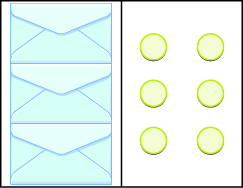 3x = 6; x = 2
3x = 6; x = 2

 2x = 8; x = 4
2x = 8; x = 4
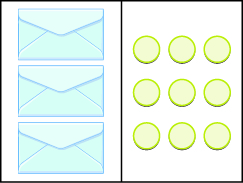 Solve Equations Using the Division Property of Equality
In the following exercises, solve each equation using the division property of equality and check the solution.
[latex-display]5x=45[/latex-display]
9
[latex-display]4p=64[/latex-display]
[latex-display]-7c=56[/latex-display]
−8
[latex-display]-9x=54[/latex-display]
[latex-display]-14p=-42[/latex-display]
3
[latex-display]-8m=-40[/latex-display]
[latex-display]-120=10q[/latex-display]
−12
[latex-display]-75=15y[/latex-display]
[latex-display]24x=480[/latex-display]
20
[latex-display]18n=540[/latex-display]
[latex-display]-3z=0[/latex-display]
0
[latex-display]4u=0[/latex-display]
Translate to an Equation and Solve
In the following exercises, translate and solve.
Four more than [latex]n[/latex] is equal to 1.
n + 4 = 1; n = −3
Nine more than [latex]m[/latex] is equal to 5.
The sum of eight and [latex]p[/latex] is [latex]-3[/latex] .
8 + p = −3; p = −11
The sum of two and [latex]q[/latex] is [latex]-7[/latex] .
The difference of [latex]a[/latex] and three is [latex]-14[/latex] .
a − 3 = −14; a = −11
The difference of [latex]b[/latex] and [latex]5[/latex] is [latex]-2[/latex] .
The number −42 is the product of −7 and [latex]x[/latex] .
−42 = −7x; x = 6
The number −54 is the product of −9 and [latex]y[/latex] .
The product of [latex]f[/latex] and −15 is 75.
f(−15) = 75; f = 5
The product of [latex]g[/latex] and −18 is 36.
−6 plus [latex]c[/latex] is equal to 4.
−6 + c = 4; c = 10
−2 plus [latex]d[/latex] is equal to 1.
Nine less than [latex]n[/latex] is −4.
m − 9 = −4; m = 5
Thirteen less than [latex]n[/latex] is [latex]-10[/latex] .
Mixed Practice
In the following exercises, solve.
Solve Equations Using the Division Property of Equality
In the following exercises, solve each equation using the division property of equality and check the solution.
[latex-display]5x=45[/latex-display]
9
[latex-display]4p=64[/latex-display]
[latex-display]-7c=56[/latex-display]
−8
[latex-display]-9x=54[/latex-display]
[latex-display]-14p=-42[/latex-display]
3
[latex-display]-8m=-40[/latex-display]
[latex-display]-120=10q[/latex-display]
−12
[latex-display]-75=15y[/latex-display]
[latex-display]24x=480[/latex-display]
20
[latex-display]18n=540[/latex-display]
[latex-display]-3z=0[/latex-display]
0
[latex-display]4u=0[/latex-display]
Translate to an Equation and Solve
In the following exercises, translate and solve.
Four more than [latex]n[/latex] is equal to 1.
n + 4 = 1; n = −3
Nine more than [latex]m[/latex] is equal to 5.
The sum of eight and [latex]p[/latex] is [latex]-3[/latex] .
8 + p = −3; p = −11
The sum of two and [latex]q[/latex] is [latex]-7[/latex] .
The difference of [latex]a[/latex] and three is [latex]-14[/latex] .
a − 3 = −14; a = −11
The difference of [latex]b[/latex] and [latex]5[/latex] is [latex]-2[/latex] .
The number −42 is the product of −7 and [latex]x[/latex] .
−42 = −7x; x = 6
The number −54 is the product of −9 and [latex]y[/latex] .
The product of [latex]f[/latex] and −15 is 75.
f(−15) = 75; f = 5
The product of [latex]g[/latex] and −18 is 36.
−6 plus [latex]c[/latex] is equal to 4.
−6 + c = 4; c = 10
−2 plus [latex]d[/latex] is equal to 1.
Nine less than [latex]n[/latex] is −4.
m − 9 = −4; m = 5
Thirteen less than [latex]n[/latex] is [latex]-10[/latex] .
Mixed Practice
In the following exercises, solve.
- ⓐ [latex]x+2=10[/latex]
- ⓑ [latex]2x=10[/latex]
- ⓐ 8
- ⓑ 5
- ⓐ [latex]y+6=12[/latex]
- ⓑ [latex]6y=12[/latex]
- ⓐ [latex]-3p=27[/latex]
- ⓑ [latex]p - 3=27[/latex]
- ⓐ −9
- ⓑ 30
- ⓐ [latex]-2q=34[/latex]
- ⓑ [latex]q - 2=34[/latex]
Everyday Math
Cookie packaging A package of [latex]\text{51 cookies}[/latex] has [latex]3[/latex] equal rows of cookies. Find the number of cookies in each row, [latex]c[/latex], by solving the equation [latex]3c=51[/latex]. 17 cookies Kindergarten class Connie’s kindergarten class has [latex]\text{24 children.}[/latex] She wants them to get into [latex]4[/latex] equal groups. Find the number of children in each group, [latex]g[/latex], by solving the equation [latex]4g=24[/latex].Writing Exercises
Is modeling the Division Property of Equality with envelopes and counters helpful to understanding how to solve the equation [latex]3x=15?[/latex] Explain why or why not. Sample answer: It is helpful because it shows how the counters can be divided among the envelopes. Suppose you are using envelopes and counters to model solving the equations [latex]x+4=12[/latex] and [latex]4x=12[/latex]. Explain how you would solve each equation. Frida started to solve the equation [latex]-3x=36[/latex] by adding [latex]3[/latex] to both sides. Explain why Frida’s method will not solve the equation. Sample answer: The operation used in the equation is multiplication. The inverse of multiplication is division, not addition. Raoul started to solve the equation [latex]4y=40[/latex] by subtracting [latex]4[/latex] from both sides. Explain why Raoul’s method will not solve the equation.Self Check
ⓐ After completing the exercises, use this checklist to evaluate your mastery of the objectives of this section. ⓑ Overall, after looking at the checklist, do you think you are well-prepared for the next Chapter? Why or why not?
ⓑ Overall, after looking at the checklist, do you think you are well-prepared for the next Chapter? Why or why not?
Chapter Review Exercises
Introduction to Integers Locate Positive and Negative Numbers on the Number Line In the following exercises, locate and label the integer on the number line. [latex-display]5[/latex-display] [latex-display]-5[/latex-display]
[latex-display]-3[/latex-display]
[latex-display]-5[/latex-display]
[latex-display]-3[/latex-display]
 [latex-display]3[/latex-display]
[latex-display]-8[/latex-display]
[latex-display]3[/latex-display]
[latex-display]-8[/latex-display]
 [latex-display]-7[/latex-display]
Order Positive and Negative Numbers
In the following exercises, order each of the following pairs of numbers, using [latex]<[/latex]; or [latex]\text{>.}[/latex]
[latex-display]4\text{__}8[/latex-display]
<
[latex-display]-6\text{__}3[/latex-display]
[latex-display]-5\text{__}-10[/latex-display]
>
[latex-display]-9\text{__}-4[/latex-display]
[latex-display]2\text{__}-7[/latex-display]
>
[latex-display]-3\text{__}1[/latex-display]
Find Opposites
In the following exercises, find the opposite of each number.
[latex-display]6[/latex-display]
−6
[latex-display]-2[/latex-display]
[latex-display]-4[/latex-display]
4
[latex-display]3[/latex-display]
In the following exercises, simplify.
[latex-display]-7[/latex-display]
Order Positive and Negative Numbers
In the following exercises, order each of the following pairs of numbers, using [latex]<[/latex]; or [latex]\text{>.}[/latex]
[latex-display]4\text{__}8[/latex-display]
<
[latex-display]-6\text{__}3[/latex-display]
[latex-display]-5\text{__}-10[/latex-display]
>
[latex-display]-9\text{__}-4[/latex-display]
[latex-display]2\text{__}-7[/latex-display]
>
[latex-display]-3\text{__}1[/latex-display]
Find Opposites
In the following exercises, find the opposite of each number.
[latex-display]6[/latex-display]
−6
[latex-display]-2[/latex-display]
[latex-display]-4[/latex-display]
4
[latex-display]3[/latex-display]
In the following exercises, simplify.
- ⓐ [latex]-\left(8\right)[/latex]
- ⓑ [latex]-\left(-8\right)[/latex]
- ⓐ −8
- ⓑ 8
- ⓐ [latex]-\left(9\right)[/latex]
- ⓑ [latex]-\left(-9\right)[/latex]
- ⓐ −32
- ⓑ 32
- ⓐ 3
- ⓑ −16
 5
[latex-display]-4-\left(-3\right)[/latex-display]
[latex-display]2-\left(-5\right)[/latex-display]
5
[latex-display]-4-\left(-3\right)[/latex-display]
[latex-display]2-\left(-5\right)[/latex-display]
 7
[latex-display]-1 - 4[/latex-display]
Simplify Expressions with Integers
In the following exercises, simplify each expression.
[latex-display]24 - 16[/latex-display]
8
[latex-display]19-\left(-9\right)[/latex-display]
[latex-display]-31 - 7[/latex-display]
−38
[latex-display]-40-\left(-11\right)[/latex-display]
[latex-display]-52-\left(-17\right)-23[/latex-display]
−58
[latex-display]25-\left(-3 - 9\right)[/latex-display]
[latex-display]\left(1 - 7\right)-\left(3 - 8\right)[/latex-display]
−1
[latex-display]{3}^{2}-{7}^{2}[/latex-display]
Evaluate Variable Expressions with Integers
In the following exercises, evaluate each expression.
[latex-display]x - 7\text{when}[/latex-display]
ⓐ [latex]x=5[/latex]
ⓑ [latex]x=-4[/latex]
7
[latex-display]-1 - 4[/latex-display]
Simplify Expressions with Integers
In the following exercises, simplify each expression.
[latex-display]24 - 16[/latex-display]
8
[latex-display]19-\left(-9\right)[/latex-display]
[latex-display]-31 - 7[/latex-display]
−38
[latex-display]-40-\left(-11\right)[/latex-display]
[latex-display]-52-\left(-17\right)-23[/latex-display]
−58
[latex-display]25-\left(-3 - 9\right)[/latex-display]
[latex-display]\left(1 - 7\right)-\left(3 - 8\right)[/latex-display]
−1
[latex-display]{3}^{2}-{7}^{2}[/latex-display]
Evaluate Variable Expressions with Integers
In the following exercises, evaluate each expression.
[latex-display]x - 7\text{when}[/latex-display]
ⓐ [latex]x=5[/latex]
ⓑ [latex]x=-4[/latex]
- ⓐ −2
- ⓑ −11
- ⓐ no
- ⓑ yes
- ⓒ no
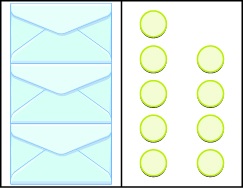 3x = 9; x = 3>
3x = 9; x = 3>
 Solve Equations Using the Division Property of Equality
In the following exercises, solve each equation using the division property of equality and check the solution.
[latex-display]8p=72[/latex-display]
9
[latex-display]-12q=48[/latex-display]
[latex-display]-16r=-64[/latex-display]
4
[latex-display]-5s=-100[/latex-display]
Translate to an Equation and Solve.
In the following exercises, translate and solve.
[latex-display]\text{The product of -6 and}y\text{is}-42[/latex-display]
−6y = −42; y = 7
[latex-display]\text{The difference of}z\text{and -13 is -18.}[/latex-display]
Four more than [latex]m[/latex] is [latex]-48[/latex].
m + 4 = −48; m = −52
[latex-display]\text{The product of -21 and}n\text{is 63.}[/latex-display]
Solve Equations Using the Division Property of Equality
In the following exercises, solve each equation using the division property of equality and check the solution.
[latex-display]8p=72[/latex-display]
9
[latex-display]-12q=48[/latex-display]
[latex-display]-16r=-64[/latex-display]
4
[latex-display]-5s=-100[/latex-display]
Translate to an Equation and Solve.
In the following exercises, translate and solve.
[latex-display]\text{The product of -6 and}y\text{is}-42[/latex-display]
−6y = −42; y = 7
[latex-display]\text{The difference of}z\text{and -13 is -18.}[/latex-display]
Four more than [latex]m[/latex] is [latex]-48[/latex].
m + 4 = −48; m = −52
[latex-display]\text{The product of -21 and}n\text{is 63.}[/latex-display]
Everyday Math
Describe how you have used two topics from this chapter in your life outside of your math class during the past month.Chapter Practice Test
Locate and label [latex]0,2,-4[/latex], and [latex]-1[/latex] on a number line. In the following exercises, compare the numbers, using [latex]<\text{or}>\text{or}\text{=.}[/latex]- ⓐ [latex]-6\text{__}3[/latex]
- ⓑ [latex]-1\text{__}-4[/latex]
- ⓐ <
- ⓑ >
- ⓐ [latex]-5\text{__}|-5|[/latex]
- ⓑ [latex]-|-2|\text{__}-2[/latex]
- ⓐ [latex]-7[/latex]
- ⓑ [latex]8[/latex]
- ⓐ 7
- ⓑ −8
Licenses & Attributions
CC licensed content, Specific attribution
- Prealgebra. Provided by: OpenStax License: CC BY: Attribution. License terms: Download for free at http://cnx.org/contents/[email protected].
